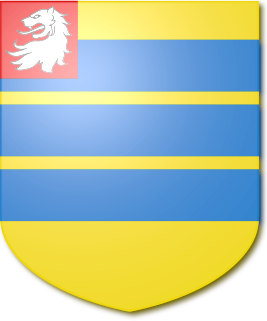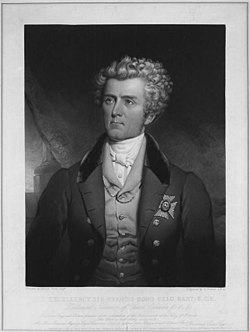
Sir Robert Burdett, 3rd Baronet DL was an English baronet and Tory politician.
The Peacocke Baronetcy, of Grange in the County of Limerick and of Barntinck in the County of Clare, was a title in the Baronetage of the United Kingdom. It was created on 24 December 1802 for Sir Joseph Peacocke, of Grange, County Limerick. Sir Joseph was the son of George Peacocke Esq. and his wife Mary (Levett) Peacocke, daughter of Joseph Levett, Alderman, of Cork, Ireland. The title became extinct on the death of his grandson, the third Baronet, in 1876.

The Boynton Baronetcy, of Barmston in the County of York, was a title in the Baronetage of England. It was created on 15 May 1618 for Matthew Boynton, son of Sir Francis Boynton of Barmston Hall, in the East Riding of Yorkshire. The Boyntons came to Barmston following the marriage of heiress Margaret de la See to Sir Henry Barmston in the 15th century. The first Baronet married Francis Griffith, heiress of an estate at Burton Agnes including Burton Agnes Hall and Burton Agnes Manor House which the second Baronet inherited in 1647. The fifth and sixth Baronets both served as High Sheriff of Yorkshire, in 1750 and 1771 respectively. The eleventh Baronet died without male issue and the Baronetcy passed to his cousin. His estates however passed to his daughter Cicely whose husband Thomas Lamplugh Wickham changed his name on marriage to Wickham-Boynton, and later (1989) to Cunliffe-Lister relations descended from Mary Constance Boynton, wife of the 1st Earl of Swinton. The title became extinct on the death of the thirteenth Baronet in 1966.

The Staunton Baronetcy, of Cargins in the County of Galway, was a title in the Baronetage of Ireland. It was created on 31 October 1785 for the Irish botanist George Staunton. He was succeeded by his son, Sir George Staunton, the second Baronet. He was a traveller, orientalist and politician. The title became extinct on his death in 1859.

Sir William Maynard, 4th Baronet of Waltons, Ashdon, Essex was a British politician and baronet.
Sir Paul Gore, 1st Baronet was an Anglo-Irish politician, soldier and baronet.
Sir Thomas Beaumont, 1st Baronet was an English politician.
Sir Henry Beaumont, 2nd Baronet was an English politician.
Sir Tristram Beresford, 1st Baronet was an Irish soldier and politician. He was the ancestor of the Marquesses of Waterford, the Barons Decies and the Beresford baronets, of William Beresford, 1st Viscount Beresford and Charles Beresford, 1st Baron Beresford.
There have been two baronetcies- both extinct- granted to the Willises of Fen Ditton, both in the Baronetage of England.
Sir Richard Head, 1st Baronet was an English politician who sat in the House of Commons from 1667 to 1679.

The Milnes baronetcy, of Gauley in the County of Leicester, was a title in the Baronetage of the United Kingdom. It was created on 21 March 1801 for the colonial governor Robert Milnes. The title became extinct on the death of the invalid second Baronet in 1839, the only surviving son, "after many years in delicate and precarious health" residing at Sydling.

Sir Roger Martin, 1st Baronet was son of Richard Martin and Jane, daughter of Sir Henry Bedingfield of Oxborough. He was created a baronet 28 March 1667 and was the first of the five Martin Baronets of Long Melford.

Sir Roger Martin, 2nd Baronet was son of Sir Roger Martin, 1st Baronet and Tamworth, daughter of Edward Horner of Mells, Somerset. He inherited his baronetcy from his father, who was the first Martin Baronet of Long Melford created on 28 March 1667, upon his death in 1712.

Sir Roger Martin, 3rd Baronet was son of Sir Roger Martin, 2nd Baronet and Anna-Marie Harvey. He inherited his baronetcy from his father, who was the second Martin Baronet of Long Melford, upon his death in 1762.
Sir Joseph Hoare, 1st Baronet was an Anglo-Irish politician.
Sir Edward Hoare, 2nd Baronet was an Anglo-Irish politician.
Sir Francis Head (1693–1768), 4th Baronet (1721–68) of Head baronets was an Anglican clergyman and landowner, of The [Great] Hermitage, Higham, in Kent. He was the younger brother of Sir Richard Head (1693–1721), 3rd Baronet (1716–21) who died unmarried, and from whom Sir Francis inherited his title.

The Cox Baronetcy, of Dunmanway in the County of Cork, was created in the Baronetage of Ireland on 21 November 1706 for Richard Cox, Lord Chancellor of Ireland. The second Baronet represented Clonakilty in the Irish House of Commons. The title presumably became extinct on the death of the 12th Baronet in 1873.
Sir Patrick Barnewall, 3rd Baronet was an Irish politician and baronet.








